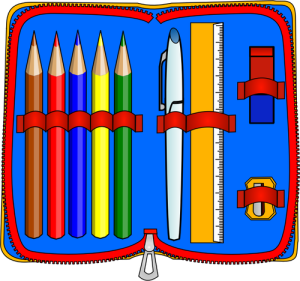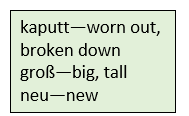2 Section 1-2: Definite Articles; Possession of Proper Names
1-2: Definite Articles; Possession of Proper Names
Here are several objects that you might find in your classroom. Notice that they all begin with the definite article–der, die, or das. All of these mean the in English. Like many foreign languages, German nouns have a particular grammatical gender. It is best to learn new words together with the definite article.

Nouns in German are always capitalized! The definite article (der/die/das) is always lowercase unless it is at the beginning of a sentence. Always capitalize the first word of each sentence.
What’s a noun? A noun is a word that refers to a person, place, thing, or idea.






1 2 3 4 5 6



![]()



7 8 9 10 11 12






13 14 15 16 17







18 19 20 21 22 23


STUDY TIP: Did you notice that all the paper products from an office are neuter? Das Buch, das Heft, und das Papier.
Ex. A: Was ist das? Ask each other about the items in your classroom. Don’t forget to include the definite article (der/die/das)! (Audio courtesy of Wikimedia user Jeuwre, Creative Commons Attribution-ShareAlike 4.0 International).
A: Was ist das? (What is that?)
B: Das ist die Tasche.

KULTURECKE: Watch Deutsch im Blick‘s video of a store that sells common school supplies. You will hear several new classroom words from this section. (Used with permission from The University of Texas at Austin | coerll.utexas.edu.)
EXTRA PRACTICE: Click the link on Germanzone.org’s website to do more online practice with definite articles and classroom objects. The site will give you feedback on your mistakes.
Or try Dr. Claudia Kost’s (University of Alberta) extra practice activity to learn the gender of the classroom words:
EXTRA PRACTICE: Need more practice with predicting patterns of a word’s gender? Click the link to Germanzone.org’s online quiz that will give you feedback: https://www.germanzone.org/noun-genders-3/.
LISTENING PRACTICE: (Audio courtesy of Light Bulb Languages, https://www.lightbulblanguages.co.uk/.
Possessive of proper names:
To show possession with proper names in German, add an -s to the end of the person’s name. If the name already ends in an -s or an “s” sound, such as -z or -ß, we add a comma to the end.
Ist das Melanies Buch?
Ritas Handy ist neu.
Reiners Computer ist kaputt.
Thomas‘ Rucksack ist zu groß.

Farben (colors)
Below are several colors that will help you describe objects with the definite articles you have already learned.

Listen to Light Bulb Languages pronouncing the colors. (Source: https://www.lightbulblanguages.co.uk/
To express different shades of these, use dunkel– or hell– affixed to the color. Do not add a space between the words.

dunkel + rot = dunkelrot
hell + blau = hellblau
Beispiel:
- Der Bleistift ist gelb.
- Die Uhr ist schwarz und weiß.
- Das Heft ist dunkelgrau.
- Das Buch ist hellgrün.

Die deutsche Fahne ist schwarz, rot und gold.
Ex. E: Welche Farbe hat das? Ask each other about the colors of the items in your classroom.
![]()
A: Welche Farbe hat das Poster?
B: Das Poster ist hellblau, gelb und rosa.

Video. Need more examples? Watch Benjamin–der Deutschleher’s video to hear the colors pronounced with lots of examples:
Or use Dr. Claudia Kost’s and Crystal Sawatzky’s (University of Alberta) flashcard examples and activities to help you learn colors:
EXTRA PRACTICE: Go to Germanzone.org’s website and do the online activities to describe the colors of each item you see. Although you may not recognize every word in the exercise, most of them are very much like English. When in doubt, use a dictionary to look it up.
Watch this Youtube video with examples of the colors rot and grün:

